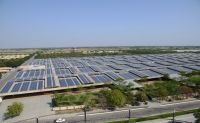
India’s forex saving policy on solar front that of local manufacturing should take place in India has to be abandoned with the WTO verdict against it. The WTO in its verdict has agreed with the US stance and directed that India’s domestic component manufacturing for energy projects under the National Solar Mission is against the National Treatment principles of WTO.
Earlier, the US, one of the largest producers of solar photovoltaic cells sued India at the WTO’s Dispute Settlement Body that India’s domestic manufacturing requirements are anti trade.
The issue was related with the Jawaharlal Nehru National Solar Mission which tried to encourage solar energy production through budgetary support. Government tried to impose local content requirement on the ground that the procured power is used from government purposes – railway and defense. Real aim was to check erosion of the benefits of the subsidy supported National Solar Mission mostly going to solar equipment providers of other countries.
India has only 5000 MW solar equipment capacities. More than that, the domestic industry is at the infancy stage. They don’t enjoy a vertical integration as in the US or China. In both countries, the solar equipment manufactures enjoy advantage of integration of the equipment manufacturing with power production. Large scale assured power purchase agreements, government incentives for green energy etc., enabled them to develop cos-effective solar equipment industry at an early stage.
Globally, there is a solar equipment glut as supply capacity is excess. India’s solar mission is a golden opportunity for US and China manufactures as India’s solar energy target is one of the biggest in the world.
The ruling may put the solar energy programme in some policy trouble. Subsidy and other incentives were given by the government for the Solar Mission to encourage emission free renewable energy production. Several environment protecting type incentives and subsidies were given for the sector. Power purchase agreements were authored despite the volatility and uncertainty of power generation from solar parks. Similarly, the biggest risk of the 100 GW solar energy target and the Solar energy programme is the pressure it may put on the balance of payment front for importing solar equipment.
*********










